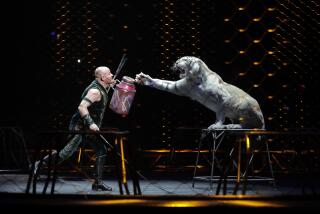Irving’s Back : This time out, ‘Garp’s’ creator takes the feverish sprawl of his story-telling to even broader canvas: India, and the circus. : A SON OF THE CIRCUS, <i> By John Irving (Random House: $25; 688 pp.)</i>
- Share via
No, there aren’t any bears or wrestlers in John Irving’s eighth novel, but even without those signature marks of his early work, his fans will feel at home here. His countryless characters don’t, though. This book has orphans and doctors and writers, a whole circus full of animals, irony and sexual ambiguity galore. It has humor. It has violence. It has Irving’s usual crowded, Dickensian canvas and, if not World War II itself, the moral equivalent.
For Irving is a moralist. This is clear now, though it wasn’t always. Perhaps the times were to blame. When he first came on the scene, most other young writers, even the angry ones, were celebrating what had been considered deviant behavior. Irving, with his strongly original voice, his love of the grotesque and a sexual frankness equal to any, could easily be mistaken for just another celebrant.
His debut, “Setting Free the Bears” (1969), begins with two Viennese students roaring off into the countryside on their motorcycles. They could be the madcap heroes of a Jack Kerouac or a Tom Robbins story--with one difference: This is Europe, not America. About halfway through, something much darker and heavier seeps into the novel. It’s Austria’s Nazi past; it’s the three-way fratricide in neighboring Yugoslavia that set the stage for that former country’s current bloodletting.
World War II casts a lighter shadow over Irving’s second novel, “The Water-Method Man” (1972), but it returns with a vengeance in “The 158-Pound Marriage” (1974). In retrospect, this seems the thinnest and meanest of his books. Its wife-swapping American academics lack seriousness, and Irving lets his contempt for them show. The hack-novelist narrator significantly misunderstands his wife, an Austrian who, as a girl in 1945, hid from the invading Red Army in the hollowed-out carcass of a cow; his fiction even fails--a low blow--to make much money.
“The World According to Garp” (1978) was Irving’s breakthrough novel. One reason is that it features his first truly admirable hero. T. S. Garp, gifted writer, obsessively loving father, advocate of the strenuously responsible life, earns a respect from his creator that balances Irving’s disdain for some of the other characters. This is essential. A Solzhenitsyn can rail all he likes at Soviet tyranny, but a moralist in a free country can’t get by on disdain alone; he needs a vision of goodness if he isn’t to sound like a party-pooper.
“Garp” also was the novel in which Irving let himself go. It’s bigger, zanier, more complex and more daring than its predecessors. Twenty years ago, while he was writing it, I attended some workshop classes Irving taught at the University of Iowa. I remember him saying how much he preferred the energy and comic expansiveness of Dickens to the modern ideal of the tight, pared-down, “well-made” novel. To the credo “less is more,” Irving replied: “More is more.”
From “The Hotel New Hampshire” (1981) on, Irving has given us more. But the problem of morality remained. He couldn’t write every novel about someone as close to him as Garp--yet he couldn’t stop expressing his dislike of the lazy, the slipshod, the cowardly, the negligent, the inauthentic, the cruel. Irving is no conservative: He opposed the Vietnam War, supports gays and abortion rights, and if he sometimes baits feminists--such as the Ellen Jamesians of “Garp”--he takes them seriously. His is a thoughtful and individual code--but it’s a stern one.
Dickens was a moralist too, of course, but his geniality offset the fury of his attacks on society. Irving is not genial. “The Cider House Rules” (1985) not only imitates the form of a Victorian novel, it may be the most Victorian novel of our times. The dire consequences of making whoopee are shown in such depressing detail that after you read it you vow never to fondle another human being--illicitly, at least--ever again. It was a prophetic book, in a way: a novel for the age of AIDS, though AIDS doesn’t appear in it.
Irving’s second breakthrough was “A Prayer for Owen Meany” (1989). Owen is a Christ figure; Irving offers us Christianity not as dogma but as possibility--as a conduit for goodness, a peg for morality to hang its hat on, a way to find meaning in a mysterious and violent world. It also helps explain Irving’s treatment of violence, which has puzzled and disturbed some readers--not so much the amount of violence as the random way it strikes characters of all ages and social conditions. Like World War II, it represents the underlying seriousness of life that can’t be evaded by moving to a different ZIP code; it’s God’s own arbitrary lightning.
“A Son of the Circus” widens this religious bridgehead and gives Irving’s talents new room to maneuver. Why go to all the trouble of setting a 633-page novel in India? Because India, with its opulence and poverty, its child laborers and prostitutes, its caste system, its leftover flourishes of the British Raj, is the most Victorian of modern countries. Its teeming background makes Irving’s convoluted plot seem natural; its obdurate foreignness let him research all the facts he wanted without risk of slipping into ordinary realism. Dickens’ stories, according to his contemporary John Ruskin, take place in “a circle of staged fire”; Irving, too, gives us worlds that are strictly his own.
The hero, Dr. Farrokh Daruwalla, is a 59-year-old neurosurgeon who was born in India, has a Viennese wife and lives in Canada. He returns periodically to Bombay to take blood samples from dwarf circus clowns--ostensibly for a genetic study of dwarfism, but in fact because Indian circuses and Bombay’s elite Duckworth Club are the only places on Earth where he feels at home.
Then an elderly golfer is murdered at the Duckworth Club. A note found on his body threatens Daruwalla’s adopted son, John, a Hindi movie star notorious for playing a sneering policeman, Inspector Dhar. The Dhar films--for which Daruwalla secretly writes the screenplays--have offended many people in Bombay, but it soon becomes clear that the murderer is a serial killer, the bodies of whose first two victims Daruwalla examined in Goa some 20 years before.
Meanwhile, John’s twin brother, Martin Mills, arrives in Bombay as a Catholic missionary. Separated at birth by their American actress mother--the old Irving spleen returns whenever he writes about Hollywood types--they are unaware of each other’s existence. Like John Wheelwright, the narrator of “Owen Meany,” he is a virgin; he is a holy fool, always bleeding from some mishap or other, who believes in doing good and won’t let the immensity of India’s problems stand in his way.
There is a lot going on in Irving’s expertly dovetailed and foreshadowed story. There is the effort by Daruwalla, John and a real police inspector, Patel, to trap the killer; there is Daruwalla’s search for a home, for a faith--his Anglicanism is wavering--and for an artistic vocation; the twins’ encounter with each other and with the truth about their parents; and nearly everybody’s fumbling over sexual identity (the possible choices in India are more numerous than here, it appears);; and there is an attempt to do some specific good by getting two children--a lame beggar and a prostitute--jobs in a circus.
“A Son of the Circus” offers a satisfying mix of evil and goodness pursued in different ways--Daruwalla quietly, Mills spectacularly, Patel coolly, professionally. It debunks both easy hope and easy cynicism. Unlike most popular novelists, Irving knows how much--and how little--to make of a serial killer. “There would never be a satisfactory motive for such hatred,” Patel thinks. “(The killer’s) real crime was that he didn’t have sufficient justification for his actions. Something about (him) would remain uncaptured.”
Indeed, this is a three-ringer of a novel: lions, chimps, elephants, vultures, acrobats, dwarfs, transsexuals, “eunuch-transvestites”; slapstick, smoke and sequins; miracles real and bogus; art intertwining with life; AIDS, drug dealing and mutilation; heartache and heroism; enough faith for the lame boy to try “skywalking” upside down across a tent roof 80 feet above ground. It’s no wonder Irving chose to write about circuses, because they turn out to be the perfect metaphor for his books: Under the Big Top, more always is more.
Katherine Dunn talks to John Irving about imagining an Indian life. Page 7
More to Read
Sign up for our Book Club newsletter
Get the latest news, events and more from the Los Angeles Times Book Club, and help us get L.A. reading and talking.
You may occasionally receive promotional content from the Los Angeles Times.









